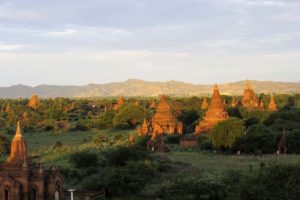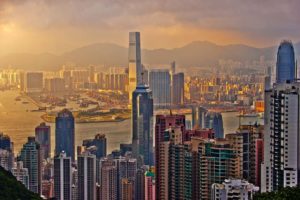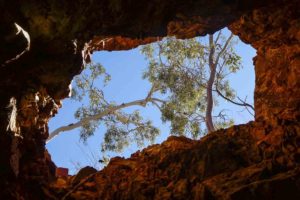The charming Bolaven Plateau, known for its exceptional coffee and dramatic waterfalls, is a place of verdant tranquillity amid the muddy scenery of rustic villages and unpretentious markets. An eclectic array of sights and sounds, coupled with the pungent aroma of the rural lifestyle, and the scent of roasted coffee, make the Bolaven Plateau a beguiling destination for those in search of a rudimentary excursion of Laos. If coffee and waterfalls aren’t your things, there is always tea, trekking or just relaxation.
The Bolaven Plateau?
The Bolaven Plateau is an elevated region in southern Laos; an ancient volcanic area, rising from 1000 to 1350 metres above sea level, which experiences cooler temperatures than the rest of Laos. With a colder climate, regular rainfall and fertile volcanic soil, the Bolaven Plateau an excellent area for growing coffee, which is evident in the exceptional quality of coffee grown here. Not surprisingly, 95% of Laos coffee is produced on the Bolaven Plateau.
How we got there…
To do the Bolaven Plateau loop, we hired scooters (motorbikes). We planned on doing the big loop and allowed ourselves four days to complete it. As this was my first big solo ride (over this sort of distance with a large pack on my back), it was not surprising our plans changed, and with our usual nonchalance, we adapted to our new agenda effortlessly.
It began to rain shortly after we had departed Pakse and it was still raining as we reached Paksong. We originally thought we would stop here for the night before continuing along the “big loop” road. We stopped at the Jhai Coffee House to try the must-talked-of coffee, and Dwayne began to search for “things to do” and accommodation options (I had handed over the responsibility of accommodation to Dwayne after my precious princess had complained about my choice of budget accommodation). Anyhow, for once I had the time to explore my surroundings whilst Dwayne sifted through the ridiculous amount of information a Google search will spit out before checking out booking.com for accommodation.
The World’s First Philanthropic Coffee Roaster!
The coffee shop we had stumbled into was more than just a shop. As I wandered the store, I discovered much paraphernalia and information pertaining to the local coffee-growing practices and, in particular, the education of the farmers regarding good farming practises, clean water, and hygiene education. It turns out that Jhai Coffee House is the world’s first philanthropic coffee roaster and cafe dedicated to breaking the cycle of poverty in the coffee farming communities of Laos. The Jhai philosophy goes something like this “buy from the source, sell at the source and reinvest profits back to the source.” 100% of Jhai’s net profit is returned to the growers in the form of clean water wells and hygiene education to support children’s health. They also serve very nice tea, and it was while we sipped the local tea that we decided to keep going. This meant we would not be making the big loop, as the “big loop” road was currently still under construction and said to be muddy and full of potholes, not a particularly good idea for a novice on a very wet day.
Searching for accommodation…
We stopped for lunch along the way at Thateng and arrived in Tad Lo early afternoon. It was time to set about looking for suitable accommodation, and we were incredibly disappointed. We looked at some of the scruffiest, dirtiest rooms we’d ever seen at prices that didn’t reflect their value.
The first and most expensive we looked at was Sayse Guesthouse and Resort. We asked to look at the room, and we then proceeded to trek (and I mean trek) along an overgrown path. Soon we were walking on a path of large rocks which was becoming increasingly slippery. Dwayne in the meantime, was muttering “how the hell is someone supposed to get back to their room in the dark?” I was wondering where the closest hospital was, as the chances of having a serious fall was not all that farfetched! We finally arrived at the room. It was bungalow style, dark, dingy, and not worth the money they wanted (about AUD 30.00). So we trekked back through the mosquito-infested jungle, thanked the lady for her time, and proceeded to move onto the next disappointment.
Then we found the perfect room…
We went on to look at another three properties before we decided to have a coffee break. Where we stopped for a coffee I notice a guesthouse sign so, once we had ordered our drinks, I asked the proprietor if they had a room available. They did, and I asked to look at it. The grounds surrounding the cabin-like rooms were lush, and there was a stream running through the area. I crossed my fingers that the room was ok. It was! It was large and clean with a large bathroom and a balcony, even a hammock! So I said I’d take it and asked how much. I was pleasantly surprised by the price of ₭60,000 (less than AUD 10). It was the cheapest room we had come across, and it was perfect.
While we had tea and coffee, we explored a map of the area and decided that we would use this charming little place as our base and explore the area on our bikes. Basically, we decided to stop the always-on-the-go travel we had, until this stage, been doing. We decided to stay the three nights here and relax and enjoy the peace. So that is what we did.
For us, the Bolaven Plateau was all about relaxation. Apart from taking some serious “timeout” laying in the hammock and reading a book, we also went for a ride to Salavan where we had lunch and explored the market. This was an exciting local market. Many local people live in small villages in the jungle where they grow the fruit and vegetables they sell at the market. If they are not growing it, they come to the markets to buy it. Some of the vendors clearly make their living from hunting, and at the markets, we saw a lot of different game for sale. There were water monitors and an animal that looked like a cross between a cat and possum for sale – we have no idea what most of the animals were. Like I said… very interesting.
Tad Lo Waterfall
Exploring the waterfalls around Tad Lo is easy. We were able to walk to Tad Hang and Tad Lo waterfalls from our accommodation, and we had a couple of local dogs join us for the trek. To get close to Tad Lo we had to scramble through the bush. I gave up and let Dwayne push his way through as I was only in flip flops and the chances of slipping were great.
Tad Soung Waterfall
We jumped on the bikes and rode out to Tad Soung where we walked to a couple of lookouts. At one stage we found ourselves at the top of the waterfall with a spectacular view across a valley and a storm rolling in. After spending a few minutes exploring the top of the waterfall, we noticed the storm front was now a wall of rain speeding frantically towards us, so we started our climb back up to our bikes. We managed to get to the top of the stairs and to a shelter before the skies opened, and a tropical deluge of mammoth proportions started with sudden gusto!
Tad Pasuam Waterfall and onwards…
When it was time to leave our little relaxing little hideaway and get back to the exploration of Laos, we packed our gear and straddled our bikes ready for the ride to Pakse. The sun was ou,t and so were the butterflies. I kept my visor down as the butterflies threw themselves at my head in a kamikaze display of bravado… We stopped at Pasuam Waterfall where we found a waterfall with a large volume of water, a gorgeous covered bamboo bridge and a unique restaurant. We enjoyed a homemade ice-cream and a walk on the bridge before a tea/coffee at the restaurant. Tad Pasuam is part of Uttayan Bajiang Natural Reserve.
It is a gorgeous place that deserved a lot more exploration. However, we were ready to move on to the 4000 islands, and hopefully a view of the rare Irrawaddy dolphins, before making our way back to Thailand. Back on the bikes we continued to our journey of Laos completely enthralled with this beautiful destination and revitalised from our break from our always-on-the-move kind of travel… it had been a perfect few days.
More Information
Currency
LAK – Laotian Kip written here as ₭
Best time to visit Bolaven Plateau…
I don’t think there is a ‘best’ time to visit this area; it would just depend on what you want to do. Laos has no coastline to influence their weather; therefore, the weather is usually quite straight forward. April through September is the rainy season, and it is during this time you will get to see the waterfalls at their best. The dry season is October through April. From October to February, you can observe and, so I’ve heard, participate in the coffee harvest.
Things to do and see
Waterfalls
Tad Lo – easy walking distance from Tad Lo village.
Tad Hang – right in the village known as Tad Lo.
Tad Suong – the tallest of the waterfalls, great view from the top.
Tad Pasuam – aka Phaxuam Cliff Falls. Uttayan Bajiang ethnic village, nature resort and restaurant.
Other waterfalls we didn’t visit (information gathered from other resources).
Tad Faek – good for a swim.
Tad Katamtok – good photo opportunity.
Tad Alang – picturesque and an eco-lodge.
Tad Fane – good photo opportunity, sound picturesque – twin falls.
Tad Gneuang – sounds a bit commercialised.
Tad Champee – supposedly the waterfall is nothing spectacular, but it is a good place to swim.
Tad Yuang – picturesque and has a picnic area.
For more about the waterfalls, click here and here.

The Bamboo Bridge at Pasuam Waterfall
Coffee
Hours – Open daily from 09:00 to 17:00
Address – Paksong
Phone – +856 20 97 672 424
Hours – 09:00 – 12:00 during harvesting season. Other shorter tours are available at other times during the year.
Email – [email protected] and [email protected]
Website – www.jhaicoffeehouse.com
Cost – ₭50,000 per person, including 2 cups of coffee
Hours – starts at 10:00 and goes for two hours.
Address – Road 16 / km 50 Ban Paksong, Champassak
Phone – +8562022760439
Email – [email protected]
Website – http://www.paksong.info/index2.php
Coffee picking season in Paksong
Bolaven Plateau and coffee tours – click here.
More on what to see and do – click here
Remote Villages and Markets – tours available or explore them on your own.

Market lady with the water monitors for sale.
Getting There
Start your loop of the Bolaven Plateau in Pakse. We caught a bus to Pakse from Konglor Cave, then rented motorbikes.
Bus – In Konglor, we returned our scooter to Nahin and caught a songthaew to Thakhet – cost ₭50,000 (AUD 8.20) each. From Thakhet we caught a large local bus to Pakse for ₭60,000 each.
Motorbike hire – ₭50,000 each/24 hours
Bus tours – Bus day tours of Bolaven Plateau are available.
Accommodation
We typically book our accommodation through booking.com. We like the convenience of booking online, and we are usually able to pay for our accommodation on arrival at the hotel/resort or room. booking.com advertise many different accommodation styles at the Bolaven Plateau, so you are sure to find the perfect place.
Palamei Guesthouse
Cost – ₭60,000 (AUD 9.80)
Pros – Large room & large bathroom with separate shower (no more wet toilet!). Balcony and hammock. Pedestal fan so you can point it where you like, mozzie net (we didn’t need to use it though), enjoyable common area and restaurant.
Cons – No internet in the rooms.
Our verdict – was a great find! The gardens around the accommodation are beautiful. The family that run the place are attentive, and the wifi in the common area was good.
Souvannasinh Hotel
Cost – ₭120,000 (AUD 19.60)
Pros – A/C, TV, Wifi, clean, tea, and coffee available free in the foyer.
Cons – No English channel on TV
Our verdict – It was a pleasant place to stay. Expensive compared to some places in Laos, but we discovered that some areas, i.e. Pakse, Luang Prabang, etc., are more costly than others.
Booking.com
Travel Insurance
Do you have insurance organised for your travels? Please take a look at our Travel Insurance page to get a quick quote! I just booked travel insurance with World Nomads again, and it always impresses me how quickly I get the quote, and in fact, the entire process, from quote to policy in hand, only takes minutes. Furthermore, you can book when you are already overseas, as I did this time!
Like this post? Please share on social media and pin using the images below… thank you!













16 Comments
Leave your reply.